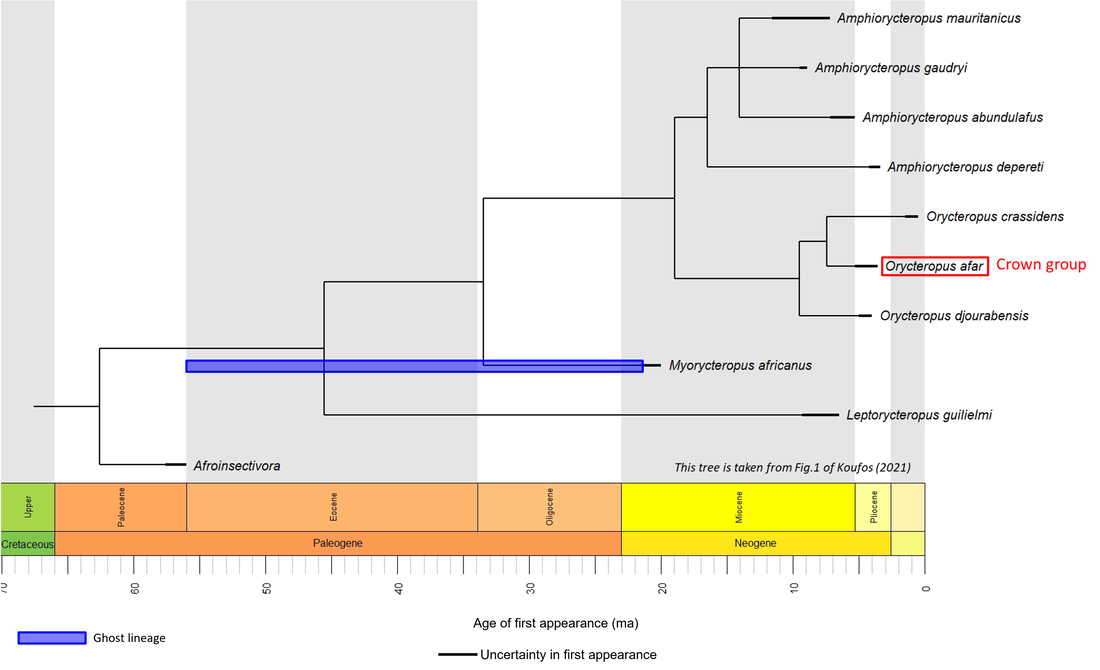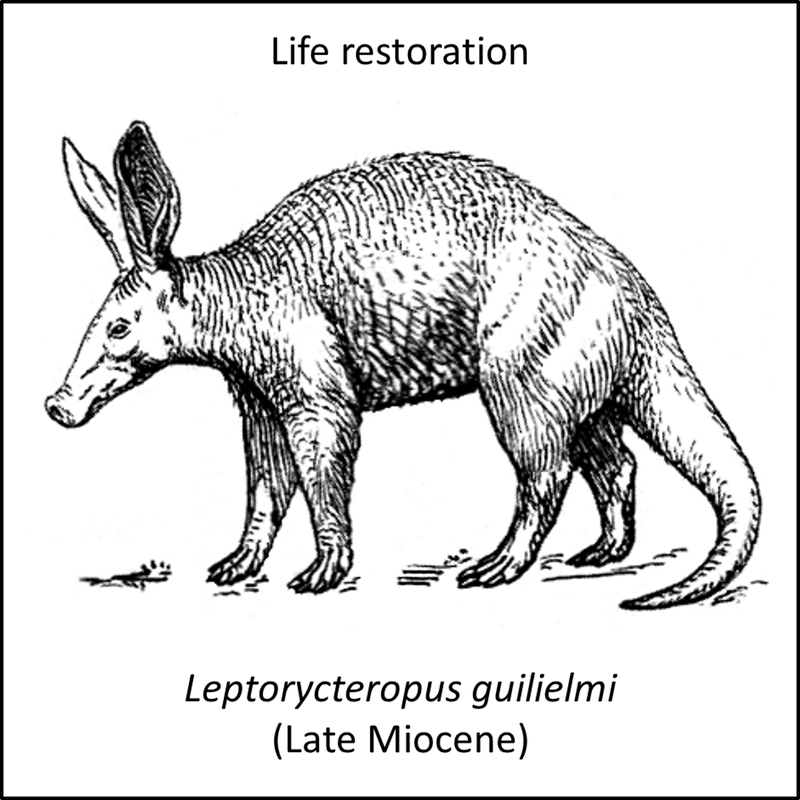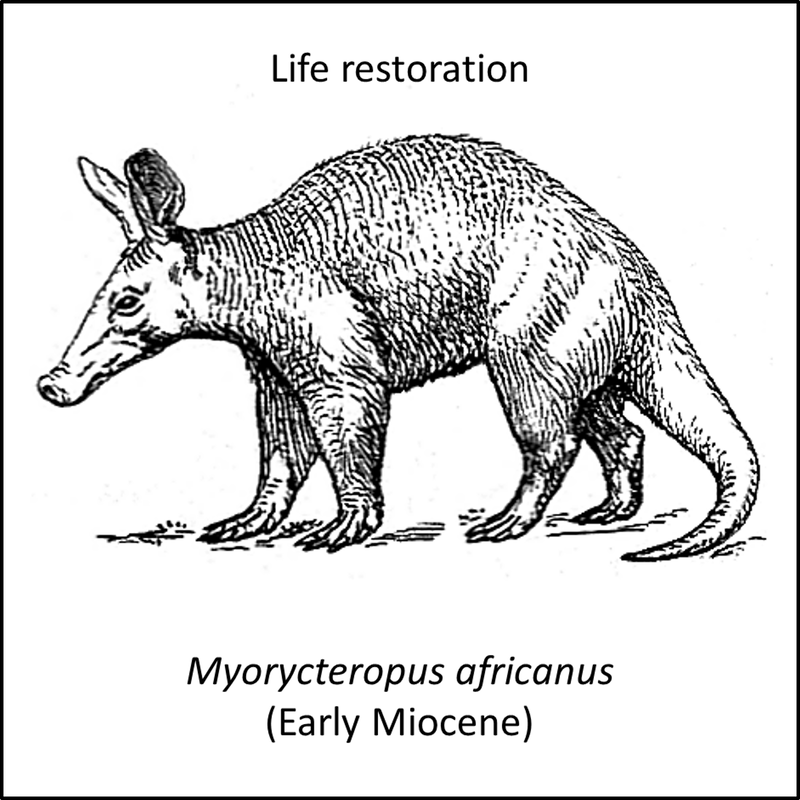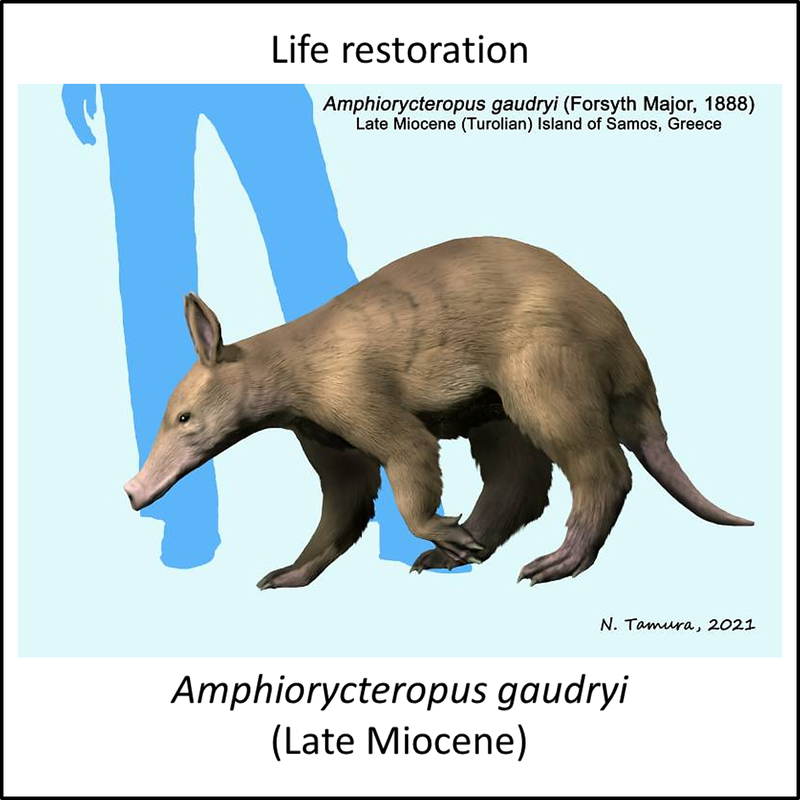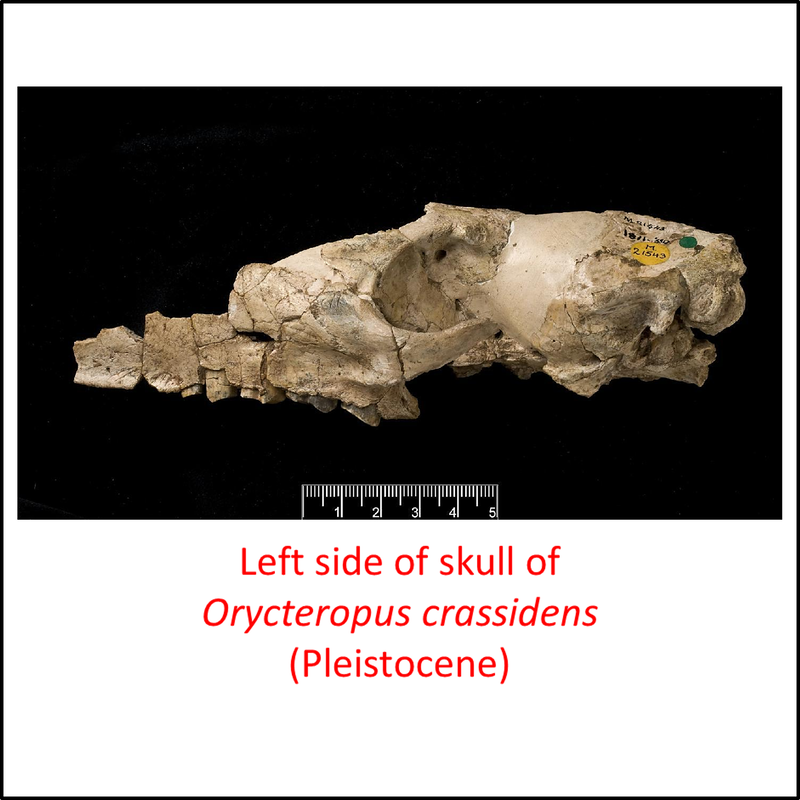The aardvarks (Order Tubulidentata, Infraclass Eutheria) are represented at the present day by a single species, Orycteropus afar, found throughout sub-Saharan Africa in savanna and semiarid areas (Encyclopaedia Britannica).
The most recently published phylogenetic tree of the stem-Tubulidentata is that of Koufos (2021). This tree forms the basis for the time tree shown below:
The most recently published phylogenetic tree of the stem-Tubulidentata is that of Koufos (2021). This tree forms the basis for the time tree shown below:
Figure 1. Time tree of the stem-Tubulidentata
The oldest known member of the stem-Tubulidentata is Myorycteropus africanus, described from Early Miocene sediments at the Napak IV locality in Uganda (Heritage et al, 2021). A life restoration of this species, together with the few other images of this stem group available in the public domain, are shown below (for a larger view, click on image):
Names in red indicate that the fossil is younger than the oldest known crown-group fossil.
Figure 2. Images of stem-Tubulidentata
The above images are ordered from most basal to most crownward, but no trends are obvious. In fact, the stem-group species appear very similar to each other and to modern aardvarks.
The single representative of the crown-Tubulidentata, Orycteropus afar, first appeared in the Pliocene (Pickford, 2005). No public-domain images are available of any fossils of this species, but a living example is shown above in the header.
The aardvark stem line includes a ghost lineage (shown as a blue bar in Figure 1), because the oldest known member of the total-group Afroinsectivora (Todralestes variabilis, of Late Thanetian age; see page on the Afroinsectivora) is at least 34 million years older than the stem-Tubulidentata, which are of Early Miocene and younger age. Given that the two stem groups must have appeared at the same time, the aardvark stem-group transition must also have begun in the Late Thanetian. This implies a stem-to-crown transition of at least 50 million years, from Late Paleocene to Pliocene time. The paucity of fossils from this long transition is striking, and allows the possibility of many new discoveries in the future.
The single representative of the crown-Tubulidentata, Orycteropus afar, first appeared in the Pliocene (Pickford, 2005). No public-domain images are available of any fossils of this species, but a living example is shown above in the header.
The aardvark stem line includes a ghost lineage (shown as a blue bar in Figure 1), because the oldest known member of the total-group Afroinsectivora (Todralestes variabilis, of Late Thanetian age; see page on the Afroinsectivora) is at least 34 million years older than the stem-Tubulidentata, which are of Early Miocene and younger age. Given that the two stem groups must have appeared at the same time, the aardvark stem-group transition must also have begun in the Late Thanetian. This implies a stem-to-crown transition of at least 50 million years, from Late Paleocene to Pliocene time. The paucity of fossils from this long transition is striking, and allows the possibility of many new discoveries in the future.
References
Heritage, S., Seiffert, E. R., & Borths, M. R. (2021). Recommended fossil calibrators for time-scaled molecular phylogenies of Afrotheria. Afrotherian Conservation 17 https://www. afrotheria. net/newsletter. php.
Koufos, G. D. (2021). The Fossil Record of Aardvarks (Mammalia: Tubulidentata: Orycteropodidae) in Greece. In Fossil Vertebrates of Greece Vol. 1: Basal vertebrates, Amphibians, Reptiles, Afrotherians, Glires, and Primates (pp. 283-290). Cham: Springer International Publishing.
Lehmann, T., Vignaud, P., Likius, A., & Brunet, M. (2005). A new species of Orycteropodidae (Mammalia, Tubulidentata) in the Mio-Pliocene of northern Chad. zoological Journal of the Linnean society, 143(1), 109-131.
Pickford, M. 2005. Orycteropus Tubulidentata, Mammalia from Langebaanweg and Baard's Quarry, Early Pliocene of South Africa. Comptes Rendus Palevol, 48, 715-726.
Koufos, G. D. (2021). The Fossil Record of Aardvarks (Mammalia: Tubulidentata: Orycteropodidae) in Greece. In Fossil Vertebrates of Greece Vol. 1: Basal vertebrates, Amphibians, Reptiles, Afrotherians, Glires, and Primates (pp. 283-290). Cham: Springer International Publishing.
Lehmann, T., Vignaud, P., Likius, A., & Brunet, M. (2005). A new species of Orycteropodidae (Mammalia, Tubulidentata) in the Mio-Pliocene of northern Chad. zoological Journal of the Linnean society, 143(1), 109-131.
Pickford, M. 2005. Orycteropus Tubulidentata, Mammalia from Langebaanweg and Baard's Quarry, Early Pliocene of South Africa. Comptes Rendus Palevol, 48, 715-726.
Image credits – stem-Tubulidentata
- Header (Aardvark - Orycteropus afar - in Royal Burgers' Zoo, Arnhem, Netherlands): Theo Kruse Burgers' Zoo, CC BY-SA 4.0 <https://creativecommons.org/licenses/by-sa/4.0>, via Wikimedia Commons
- Figure 2 (Leptorycteropus guilielmi): A. C. Tatarinov, CC0, via Wikimedia Commons
- Figure 2 (Myorycteropus africanus): A. C. Tatarinov, CC0, via Wikimedia Commons
- Figure 2 (Amphiorycteropus gaudryi): Nobu Tamura under Creative Commons Attribution-ShareAlike (CC BY-SA) license
- Figure 2 (Orycteropus crassidens): The Trustees of the Natural History Museum, London under a Creative Commons Attribution 4.0 International (CC BY 4.0) License
